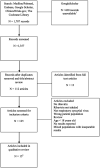The Use of Aerosolized Ribavirin in Respiratory Syncytial Virus Lower Respiratory Tract Infections in Adult Immunocompromised Patients: A Systematic Review
- PMID: 32742010
- PMCID: PMC7370350
- DOI: 10.1177/0018578719836646
The Use of Aerosolized Ribavirin in Respiratory Syncytial Virus Lower Respiratory Tract Infections in Adult Immunocompromised Patients: A Systematic Review
Abstract
Introduction: Respiratory syncytial virus (RSV)-associated lower respiratory tract infection (LRTI) is a concern in immunocompromised patients. Aerosolized ribavirin (RBV AER) is used for treatment of RSV LRTI; however, adverse events and rising drug costs remain a challenge for patient management. The purpose of this systematic review is to summarize the efficacy and adverse event profile of RBV AER for the treatment of hospitalized RSV LRTI in immunocompromised adult patients. Methods: A Medline/PubMed, Embase, Google Scholar, Clinicaltrials.gov, and Cochrane Library database search was conducted from 1966 to January 2019 for the use of RBV AER. Search strategy: [(ribavirin OR ICN1229) AND ("administration, oral" OR "oral" OR "administration, inhalation" OR "inhalation)] AND ("respiratory tract infection" OR "pneumonia"). Studies were reviewed if adult patients were hospitalized, immunocompromised, had RSV LRTI, received RBV AER, and included the outcome of mortality and/or adverse reactions. Methodological quality was assessed using the Cochrane Collaboration GRADE approach. Results: A total of 1787 records were identified and 15 articles met inclusion criteria: hematopoietic stem cell transplant (HSCT)/bone marrow transplant (n = 8), other malignancy/neutropenic (n = 2), solid organ transplant (n = 5). All of the trials are observational with a low quality rating; therefore, a meta-analysis was not performed. The 30-day mortality in studies that contain >10 patients with HSCT, malignancy, and transplant range from 0 to 15.4%, 6.3%, and 0 to 27%, respectively. Improved mortality was cited in 4 studies when RBV AER started before mechanical ventilation or within 2 weeks of symptom onset. Only 3 studies had comparative mortality data with RBV AER and RBV PO. Adverse reactions were reported in 5 studies and included psychiatric manifestations (anxiety, depression, feeling of isolation; n = 14), wheezing/bronchospasm (n = 6), snowflakes/hail blowing in face (n = 6), and precipitation in ventilator tubing (n = 5). Conclusion: There is a lack of high quality, comparative trials on the use of RBV AER for the treatment of RSV LRTI in adult hospitalized immunocompromised patients. There may be a mortality benefit when RBV AER is initiated early after diagnosis or prior to mechanical ventilation, but requires further study. Patient isolation and psychological effects must be weighed against the benefit of therapy.
Keywords: immunocompromised; lower respiratory tract infection; respiratory syncytial virus; ribavirin; systematic review.
© The Author(s) 2019.
Conflict of interest statement
Declaration of Conflicting Interests: The author(s) declared no potential conflicts of interest with respect to the research, authorship, and/or publication of this article.
Figures

Similar articles
-
Current practices for treatment of respiratory syncytial virus and other non-influenza respiratory viruses in high-risk patient populations: a survey of institutions in the Midwestern Respiratory Virus Collaborative.Transpl Infect Dis. 2016 Apr;18(2):210-5. doi: 10.1111/tid.12510. Epub 2016 Mar 29. Transpl Infect Dis. 2016. PMID: 26923867 Free PMC article.
-
Comparative effectiveness of aerosolized versus oral ribavirin for the treatment of respiratory syncytial virus infections: A single-center retrospective cohort study and review of the literature.Transpl Infect Dis. 2018 Apr;20(2):e12844. doi: 10.1111/tid.12844. Epub 2018 Mar 31. Transpl Infect Dis. 2018. PMID: 29360277 Review.
-
Oral Versus Aerosolized Ribavirin for the Treatment of Respiratory Syncytial Virus Infections in Hematopoietic Cell Transplant Recipients.Clin Infect Dis. 2019 May 2;68(10):1641-1649. doi: 10.1093/cid/ciy760. Clin Infect Dis. 2019. PMID: 30202920 Free PMC article.
-
Prophylaxis and treatment of respiratory syncytial virus in adult immunocompromised patients.Ann Pharmacother. 2012 Apr;46(4):558-66. doi: 10.1345/aph.1Q553. Epub 2012 Mar 6. Ann Pharmacother. 2012. PMID: 22395247 Review.
-
Successful systemic high-dose ribavirin treatment of respiratory syncytial virus-induced infections occurring pre-engraftment in allogeneic hematopoietic stem cell transplant recipients.Transpl Infect Dis. 2013 Aug;15(4):435-40. doi: 10.1111/tid.12092. Epub 2013 May 20. Transpl Infect Dis. 2013. PMID: 23692664
Cited by
-
Oral dosing of the nucleoside analog obeldesivir is efficacious against RSV infection in African green monkeys.Nat Commun. 2025 Jul 11;16(1):6437. doi: 10.1038/s41467-025-61595-3. Nat Commun. 2025. PMID: 40645925 Free PMC article.
-
Deconstruction of Clinical Treatment of Pneumonia and Respiratory Tract Infection Based on MRI Molecular Imaging.Contrast Media Mol Imaging. 2022 Sep 26;2022:7146978. doi: 10.1155/2022/7146978. eCollection 2022. Contrast Media Mol Imaging. 2022. Retraction in: Contrast Media Mol Imaging. 2023 Nov 29;2023:9823903. doi: 10.1155/2023/9823903. PMID: 36237582 Free PMC article. Retracted. Clinical Trial.
-
EDP-323, a First-In-Class, Once-Daily, Oral L-Protein Inhibitor for the Treatment of RSV: Results From a Phase 1 Study in Healthy Adults.Clin Transl Sci. 2025 May;18(5):e70231. doi: 10.1111/cts.70231. Clin Transl Sci. 2025. PMID: 40293399 Free PMC article. Clinical Trial.
-
Advances and Challenges in Antiviral Development for Respiratory Viruses.Pathogens. 2024 Dec 31;14(1):20. doi: 10.3390/pathogens14010020. Pathogens. 2024. PMID: 39860981 Free PMC article. Review.
-
Ribavirin for Treatment of Subjects with Respiratory Syncytial Virus-Related Infection: A Systematic Review and Meta-Analysis.Adv Ther. 2022 Sep;39(9):4037-4051. doi: 10.1007/s12325-022-02256-5. Epub 2022 Jul 25. Adv Ther. 2022. PMID: 35876973
References
-
- Food and Drug Administration. Drugs@FDA: FDA Approved Drug Products. Date unknown. http://www.accessdata.fda.gov/scripts/cder/drugsatfda/index.cfm. Accessed January 23, 2019.
LinkOut - more resources
Full Text Sources
Miscellaneous

